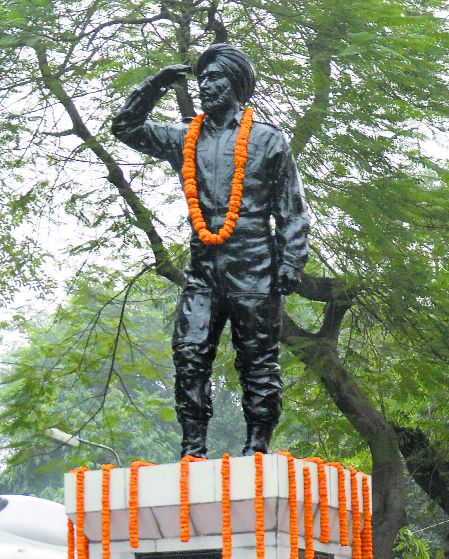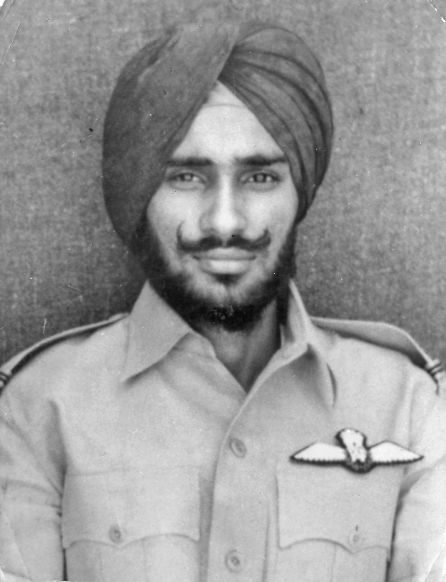
The statue of Flying Officer Nirmaljit Singh Sekhon at the Mini Secretariat in Ludhiana. Tribune photo: Inderjeet Verma
Air Vice Marshal Arjun Subramaniam (Retd)
Sprinting out of an underground shelter as the tannoy (a term used to denote a public address system in older colloquial British English) blares is bread and butter stuff for fighter pilots in the Indian Air Force as they respond to a scramble order to intercept intruding enemy aircraft. Not many, however, would have imagined in the wildest of their dreams that they would have to scramble their jets during an enemy bombing raid that involved four aircraft already in the process of dropping their bombs over targets on the airfield. This is exactly the situation that young Flying Officer Nirmaljit Singh Sekhon found himself in on December 14, 1971, at Srinagar airfield as part of an air defence detachment of four Gnat fighters from 18 Squadron, also called the Flying Bullets.

Srinagar during those days was not a base that had a fighter squadron permanently located due to the restrictions imposed on India not to base fighter aircraft at air bases in J&K following the UN-sponsored ceasefire in 1947-48. Strangely, this was not revised even after the 1965 India-Pakistan war. Air Marshal Manjit Singh Sekhon, himself a Vir Chakra awardee from the 1971 war for his exploits while flying Vampires from 121 Squadron out of Srinagar and who was closely related to Nirmaljit Sekhon, recalls that the latter was full of ‘josh’. Much older and hailing from the same village Issewal in Ludhiana, he recalls having advised Nirmaljit to focus on becoming an officer in the IAF. He also remembers that both squadrons were put up in the same officer’s mess at Badami Bagh and that during the conflict, Nirmaljit would often walk up to his room and say in Punjabi, ‘Dhuan udani hai’ — meaning that he wanted to ‘smoke out the Pakistanis in battle’.
Battle-inoculated well before his epic dogfight over Srinagar airfield, Nirmaljit Sekhon had escorted Manjit Sekhon’s formation of Vampires a few days earlier as the latter attacked the Hajira Brigade of the Pakistan army and enemy artillery guns at Dwarandi, both in the Poonch sector. Unable to resist the temptation of joining the party, the Gnats emptied their guns on the targets after the Vampires completed their attack before returning to Srinagar.
Though Air Chief Marshal Lal had instituted several measures to improve early warning of incoming strike aircraft through a layered network of radars and Mobile Observation Posts (MOPs), the mountainous terrain and valleys offered excellent cover for enemy aircraft to conceal their approach while attacking airfields such as Srinagar. Therefore, the only way for air defence aircraft like the Gnats to intercept incoming strike aircraft was if they had at least five-six minutes of warning that would allow them to scramble in two-three minutes, and then allow the air defence radar to carry out an intercept before the strike hits the target. No such window was available on December 14, the day that Sekhon was part of a two-aircraft air defence mission that was on readiness at Srinagar.
Masking themselves with tactical finesse and penetrating the Srinagar valley with ease, a six-aircraft Sabre formation from the PAF’s 26 Squadron led by their squadron commander, Wing Commander Changezi, swooped down on Srinagar airfield at 7.30 am. Comprising four aircraft for airfield attack and two staying high to provide air defence cover, the Sabres thought it would be a cakewalk for them and like a few times earlier, they would exit the Valley before the Gnats were scrambled. This time, however, they did not expect the speed with which Flight Lieutenant BS Ghuman and Flying Officer Sekhon would scramble into the air. Having got airborne before Sekhon as the Number One, Ghuman gained height and turned around to pick up his Number Two, but lost sight of everything below as there was a thick layer of haze between 1,000 and 3,000 feet.
Sekhon, meanwhile, miraculously got airborne even as the first Sabre pair had dropped its bombs on the runway while the second pair was diving for the attack. So, you had two Sabres at over 750 km/hr with Sekhon’s Gnat behind one of them as he built up his speed quickly and commenced manoeuvring to get a shot on the Sabre leader, while the other Sabre attempted to get behind him. Two Sabres dropped their load and headed home while Changezi called on the two loitering Sabres to come into the fight from above. Despite being outnumbered 4:1, Sekhon fought on, calling for Ghuman to support him and forcing the Sabre behind him to exhaust the ammo. Unfortunately, Ghuman had lost contact in the haze and could not join the fray. Out of ammunition and vulnerable to the second pair of Sabres which had its ammo intact, Sekhon’s aircraft was hit by several bursts of concentrated fire and went down close to Badgam, the site of another epic battle in November 1947 where Major Somnath Sharma was awarded a Param Vir Chakra as his company of 4 Kumaon stalled the enemy’s advance towards Srinagar airfield. Sekhon attempted an ejection, but was too close to the ground and perished in action. Among the Indian accounts of that battle, a 2017 piece by KS Nair in Indian Defence Review and a terrific YouTube animation by Anurag Rana offer the finest accounts. Kaiser Tufail provides the best PAF perspective in his blog ‘Aeronaut’, where he calls Sekhon a ‘hard nut to crack’, and describes the combat with flair as Sekhon ‘snatched degrees at a dizzying rate’.
While it is possible that Sekhon had scored a few hits, and inflicted some damage on one of the Sabres, the PAF claims that all the Sabres returned to Peshawar undamaged. However, there is ungrudging admiration for Sekhon from all his adversaries who were involved in that day’s combat. For his ‘sublime heroism, supreme gallantry, flying skill and determination above and beyond the call of duty in the face of certain death’, Flying Officer Nirmaljit Singh Sekhon was awarded the IAF’s only Param Vir Chakra till date.
— The writer, a retired fighter pilot, occupies the President’s Chair of Excellence at National Defence College, New Delhi
Join Whatsapp Channel of The Tribune for latest updates.



























